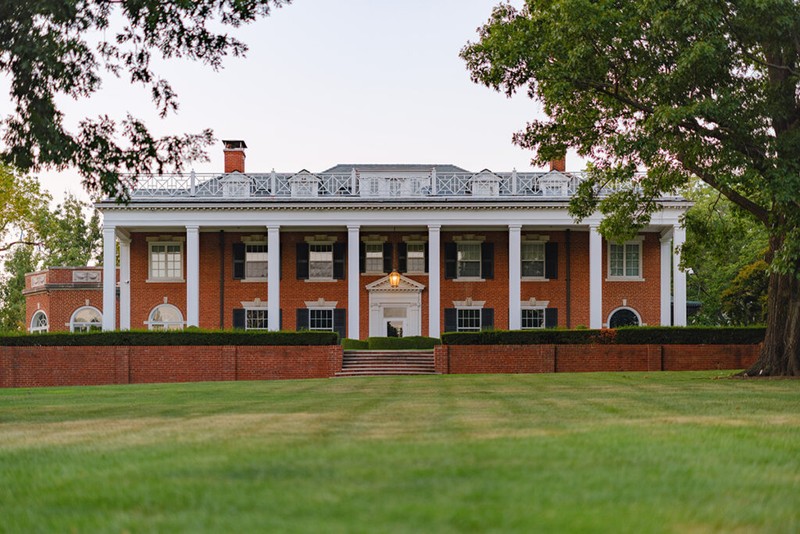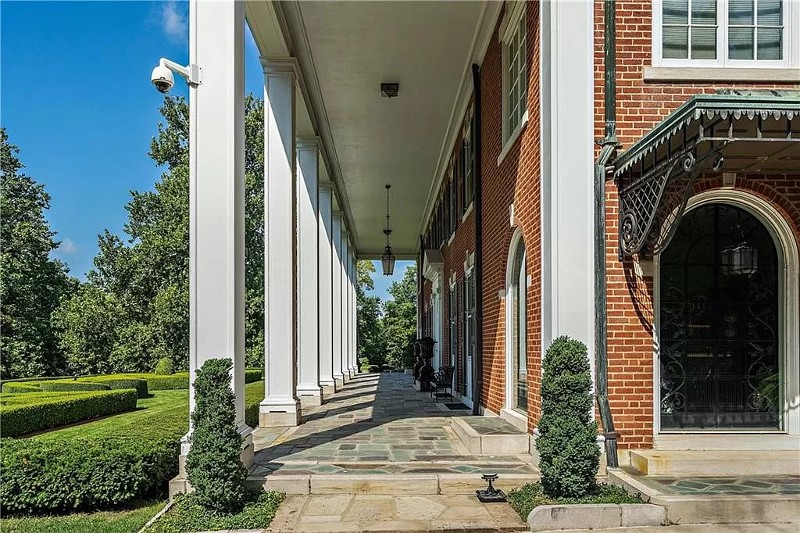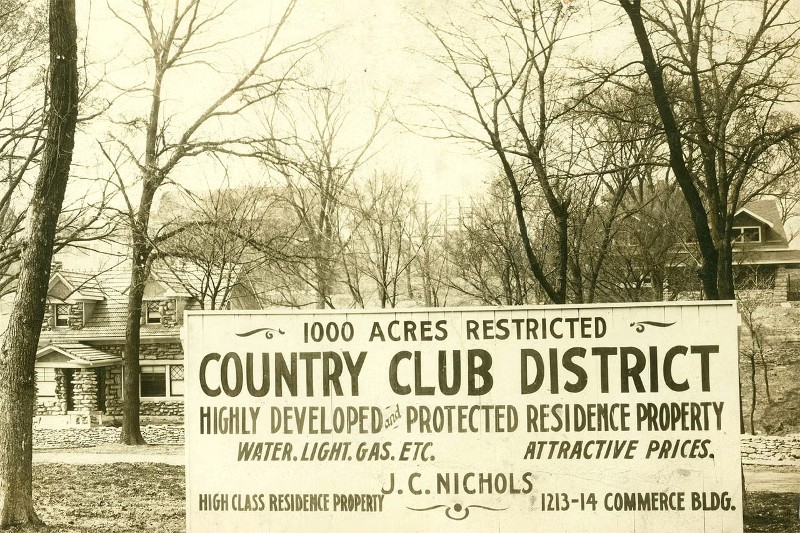Hunter Gary House
Introduction
Text-to-speech Audio
The Neoclassical-style mansion was constructed in 1922 for the family of entrepreneur Hunter Gary, who followed his father's footsteps and expanded the family's growing fortune in the telephone business and other investments that shaped early Kansas City. The estate was designed by acclaimed Kansas City architect John Van Brunt, Sr., and represents the high-end residential architecture constructed in Kansas City's most exclusive subdivisions in the early 20th century. The house is near Ward Parkway in the Country Club District, part of the city's parks and boulevard system that connected the city to the neighboring residential area, which was developed by J.C. Nichols around 1906. Today, Nichols is known both for innovative urban planning and for including restrictions that prevented Jewish and African American residents from purchasing property. Brunt drew inspiration from George Washington's eighteenth-century stately Mount Vernon residence in designing the estate for Hunter Gary. Like Mount Vernon, the Gary House is a rectangular mass capped by a hip roof with symmetrical pairs of interior chimneys. The home was sold to furniture maker Harry Abernathy in 1941 and was later home to the owner of a flour mill empire and a leading clothing manufacturer.
Images
Hunter Gary House

Hunter Gary House

Hunter Gary House

Postcard of Brookside Boulevard in the Country Club District

A sign that alludes to the racial and economic restrictions attached to the Country Club District

The use of deed restrictions in subdivision development, 1928

Backstory and Context
Text-to-speech Audio
Hunter L. Gary was born in 1884 in Macon, Missouri. His father, Theodore, began his career as a lightning rod salesman before purchasing his first small telephone system in Macon, Missouri, in 1897. Theodore Gary & Company enjoyed expansive growth in its first decade, pushing Theodore to move its headquarters to Kansas City in 1907. Hunter began working for his father in 1912 and became the company's first vice president and treasurer by the 1920s.
In 1922, Hunter Gary sought to build his home in a neighborhood befitting his wealth and social status, and chose to build his new, grand estate in the Country Club District. Famed urban planner, J.C. Nichols designed the community. City planners throughout the U.S. copied his ideas for neighborhood planning in Kansas City while also putting into place restrictive covenants in property deeds, a practice used by other developers in Kansas City and around the nation. Several of Nichols' residential developments were located south of the city's downtown region, following the movement of wealthy residents in a southerly direction. In 1907, the Nichols Investment Company purchased approximately 1,000 acres of land beyond the city limits that became the Country Club District, named for the nearby Kansas City Country Club.
In the Country Club District, Nichols built suburban infrastructure, including roads that followed the terrain, cul-de-sacs, buried water and sewer lines, and abundant green space, fountains, and other landscaping features. The District also included plenty of strategies, rules, and deed restrictions that prevented (or expressly forbade) people of color from living in the communities.
The historic home's Neoclassical style, with its classic Green and Roman features, was popular in residential, commercial, and civic architecture from around 1895 to 1950. The style, which usually incorporates other class-inspired influences such as the Georgian Revival and Greek Revival, grew exceptionally popular after the 1893 World's Columbian Exposition in Chicago in 1893. Millions of visitors viewed the fair's "White City," a host of grand Neoclassical white buildings, giving birth to the architectural trend. Banks and government buildings emerged as the first to embrace the Neoclassic look. Still, the movement became prevalent among wealthy citizens who likewise desired their homes to express their success, influence, and importance.
The design for Hunter Gary's home drew influence from George Washington's Mount Vernon estate. Like Mount Vernon, the Gary House is a rectangular mass capped by a hip roof with symmetrical pairs of interior chimneys. The porch traversing the front of the Gary House has a flagstone floor and eight square columns supporting a shallow roof. In 1928, Gary hired another architect to update the kitchen and add a breakfast room and sunroom. The Gary House originally had a balustrade across the porch that echoed the Mount Vernon roof line, although occupants removed this feature sometime in the 1950s.
Gary lived in the home until he died in 1937, and his wife lived there a few more years before selling the property to Harry and Bessie Cook Abernathy in 1941. Harry T. Abernathy's father garnered wealth as one of Kansas' first furniture manufacturers. After Abernathy earned a law degree in New York in 1887, he returned to Kansas to work for the family company. Within five years, Abernathy became company treasurer. Meanwhile, in 1886, his father entered into a partnership to open the First National Bank in the heart of Kansas City's business district, which survived the national economic "panic" of 1893 and is now home to the Central Branch of the Kansas City Public Library. Abernathy, who never loved the furniture business, again took a job with his father, working at the bank as a teller assistant. And, just as he had done in the furniture business, Abernathy climbed the corporate ladder, becoming a cashier in 1900, bank vice-president in 1908, president of First National Bank in 1928, and finally Chairman of the Board in 1941, the year he purchased the historic mansion.
Harry T. Abernathy died in 1948 at age 83; his wife, Bessie Cook Abernathy, moved out of the house the following year. Henry Cate, president of Flour Mills of America, Inc. purchased the home with his wife Gladys in 1949 and the couple lived there until 1953. Clothing manufacturers Grace and John Van Brunt, Jr. lived in the historic home until they died in 1973 and 1974, respectively; John Van Brunt, Jr. was the son of architect John Van Brunt, who designed the house for Hunter Gary.
The house has had several owners since the Brunt's died, but it survives as a reminder of early-twentieth-century culture and economics. Like Hunter Gary, many families that enjoyed Gilded Age success passed on wealth and job opportunities to their children. Meanwhile, as older neighborhoods closer to the city center saw outmigration and decline, wealthy families people moved away from downtown regions to neighborhoods like the Country Club District. The grand home's Neoclassic style represents an architectural trend for civic, commercial, and residential buildings that spoke to the status and influence of its occupants.
Sources
Dent, Mark. "The Man Who Made the Suburbs White." Slate.com. August 16, 2023. https://slate.com/business/2023/08/jc-nichols-covenants-segregation-development-zoning.html.
Ford, Susan Jezak. J. C. Nichols: Developer: 1880-1950. Kansas City Public Library. Accessed June 10, 2024. https://kchistory.org/document/biography-j-c-nichols-1880-1950-developer.
"Hunter Larrabee Gary's Obit" Newspapers.com. Macon Chronicle-Herald, December 2, 1946. https://www.newspapers.com/article/macon-chronicle-herald-hunter-larrabee-g/5252034/.
Stevens Sara. "J.C. Nichols and the Country Club District: Suburban Aesthetics and Property Values." The Pendergast Years. Kansas City Public Library. Accessed June 10, 2024. https://pendergastkc.org/articles/jc-nichols-and-country-club-district-suburban-aesthetics-and-property-values.
Rosin, Elizabeth. "Registration Form: Gary, Hunter, House." National Register of Historic Places. mostateparks.com. 2007. https://mostateparks.com/sites/mostateparks/files/Gary%2C%20Hunter%2C%20House.pdf.
Brandon Waldrop, https://kansascitymag.com/an-early-telephone-pioneer-built-one-of-kcs-most-coveted-and-iconic-homes/
Keller Williams Realty Partners, Inc., https://missourilegends.com/2023/11/30/hunter-gary-house-in-kansas-city/
Keller Williams Realty Partners, Inc., https://missourilegends.com/2023/11/30/hunter-gary-house-in-kansas-city/
Courtesy of the Missouri Valley Special Collections at https://pendergastkc.org/articles/jc-nichols-and-country-club-district-suburban-aesthetics-and-property-values
https://slate.com/business/2023/08/jc-nichols-covenants-segregation-development-zoning.html
Helen Monchow, https://pendergastkc.org/articles/jc-nichols-and-country-club-district-suburban-aesthetics-and-property-values
